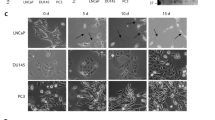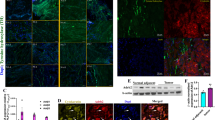Abstract
Neuroendocrine (NE) differentiation in prostate cancer (CaP) has been reported to be an early marker associated with the development of androgen independence. The mechanisms by which CaP acquires NE properties are poorly understood. In this study, a putative role of adrenomedullin (AM) in the NE differentiation was investigated. The expression of AM and AM receptors (calcitonin receptor-like receptor (CRLR)/receptor activity modifying protein-2 and -3 (RAMP2 and RAMP3) was evaluated after experimental manipulation of androgen status. Levels of AM mRNA and immunoreactive AM (ir-AM) increased four- to sevenfold in androgen-sensitive LNCaP cells after androgen withdrawal in vitro and in LNCaP xenografts in animals after castration. Treatment of LNCaP cells with androgen analogue (dihydrotestosterone; 10−9 M) prevented the increase in AM mRNA and ir-AM levels. Interestingly, the expression of CRLR, RAMP2 and RAMP3 is not regulated by androgen status. We demonstrate that in the presence of serum, AM is able to induce an NE phenotype in LNCaP cells via CRLR/RAMP2 and RAMP3, which includes extension of neuritic processes and expression of the neuron-specific enolase (NSE), producing cGMP in a dose-dependent manner, which is mediated by a pertussis toxin-sensitive GTP-binding protein. 8-bromo-cGMP mimicked the effects of AM on cell differentiation. We demonstrate that AM induces a G-kinase Iα translocation to the nucleus. The protein kinase G inhibitor KT-5823 inhibited the neurite outgrowth induced by both AM and 8-bromo-cGMP. In noncastrated animals, administration of AM enhanced expression of NSE and chromogranin A in LNCaP xenografts with a significant increase of NSE levels in serum and no changes in tumor growth. In castrated animals, intraperitoneal injection of AM resulted in a 240±18% (P<0.001) increase in tumor volume 36 days after treatment, indicating that the nature of effect of AM in CaP depends on the presence or absence of endogenous androgen. Together, these results demonstrate that AM may function as a mediator of NE-like differentiation in culture as well as in vivo and indicate that its production may be important for tumor resurgence following androgen ablation.
This is a preview of subscription content, access via your institution
Access options
Subscribe to this journal
Receive 50 print issues and online access
$259.00 per year
only $5.18 per issue
Buy this article
- Purchase on Springer Link
- Instant access to full article PDF
Prices may be subject to local taxes which are calculated during checkout











Similar content being viewed by others
References
Abasolo I, Yang L, Haleem R, Xiao W, Pio R, Cuttitta F et al. (2003). Overexpression of adrenomedullin gene markedly inhibits proliferation of PC3 prostate cancer cells in vitro and in vivo. Mol Cell Endocrinol 199: 179–187.
Abrahamsson PA . (1999). Neuroendocrine differentiation in prostatic carcinoma. Prostate 39: 135–148.
Blutt SE, Allegretto EA, Pike JW, Weigel NL . (1997). 1,25-dihydroxyvitamin D3 and 9-cis-retinoic acid act synergistically to inhibit the growth of LNCaP prostate cells and cause accumulation of cells in G1. Endocrinology 138: 1491–1497.
Butt E, Geiger J, Jarchau T, Lohmann SM, Walter U . (1993). The cGMP-dependent protein kinase – gene, protein, and function. Neurochem Res 18: 27–42.
Chung TD, Yu JJ, Spiotto MT, Bartkowski M, Simons JW . (1999). Characterization of the role of IL-6 in the progression of prostate cancer. Prostate 38: 199–207.
Costantini LC, Isacson O . (2000). Immunophilin ligands and GDNF enhance neurite branching or elongation from developing dopamine neurons in culture. Exp Neurol 164: 60–70.
Cox ME, Deeble PD, Bissonette EA, Parsons SJ . (2000). Activated 3′,5′-cyclic AMP-dependent protein kinase is sufficient to induce neuroendocrine-like differentiation of the LNCaP prostate tumor cell line. J Biol Chem 275: 13812–13818.
Cox ME, Deeble PD, Lakhani S, Parsons SJ . (1999). Acquisition of neuroendocrine characteristics by prostate tumor cells is reversible: implications for prostate cancer progression. Cancer Res 59: 3821–3830.
Deeble PD, Murphy DJ, Parsons SJ, Cox ME . (2001). Interleukin-6- and cyclic AMP-mediated signaling potentiates neuroendocrine differentiation of LNCaP prostate tumor cells. Mol Cell Biol 21: 8471–8482.
Fernandez-Sauze S, Delfino C, Mabrouk K, Dussert C, Chinot O, Martin PM et al. (2004). Effects of adrenomedullin on endothelial cells in the multistep process of angiogenesis: involvement of CRLR/RAMP2 and CRLR/RAMP3 receptors. Int J Cancer 108: 797–804.
Gkonos PJ, Krongrad A, Roos BA . (1995). Neuroendocrine peptides in the prostate. Urol Res 23: 81–87.
Hinson JP, Kapas S, Smith DM . (2000). Adrenomedullin, a multifunctional regulatory peptide. Endocr Rev 21: 138–167.
Kim J, Adam RM, Freeman MR . (2002). Activation of the Erk mitogen-activated protein kinase pathway stimulates neuroendocrine differentiation in LNCaP cells independently of cell cycle withdrawal and STAT3 phosphorylation. Cancer Res 62: 1549–1554.
McLatchie LM, Fraser NJ, Main MJ, Wise A, Brown J, Thompson N et al. (1998). M. RAMPs regulate the transport and ligand specificity of the calcitonin-receptor-like receptor. Nature 393: 333–339.
Nikitenko LL, Fox SB, Kehoe S, Rees MC, Bicknell R . (2006). Adrenomedullin and tumour angiogenesis. Br J Cancer 94: 1–7.
Ouafik L, Sauze S, Boudouresque F, Chinot O, Delfino C, Fina F et al. (2002). Neutralization of adrenomedullin inhibits the growth of human glioblastoma cell lines in vitro and suppresses tumor xenograft growth in vivo. Am J Pathol 160: 1279–1292.
Pilz RB, Casteel DE . (2003). Regulation of gene expression by cyclic GMP. Circ Res 93: 1034–1046.
Rocchi P, Boudouresque F, Zamora AJ, Muracciole X, Lechevallier E, Martin PM et al. (2001). Expression of adrenomedullin and peptide amidation activity in human prostate cancer and in human prostate cancer cell lines. Cancer Res 61: 1196–1206.
Spiotto MT, Chung TD . (2000). STAT3 mediates IL-6-induced neuroendocrine differentiation in prostate cancer cells. Prostate 42: 186–195.
Acknowledgements
This study was supported by grants from Inserm, APHM. The Association pour la Recherche sur les Tumeurs de la Prostate (ARTP) and Association pour la recherche contre le cancer (ARC) supported CB. We thank Mylène Cayol for her skillful technical assistance. We thank Véronique Gagna for her excellent secretarial assistance.
Author information
Authors and Affiliations
Corresponding author
Rights and permissions
About this article
Cite this article
Berenguer, C., Boudouresque, F., Dussert, C. et al. Adrenomedullin, an autocrine/paracrine factor induced by androgen withdrawal, stimulates ‘neuroendocrine phenotype’ in LNCaP prostate tumor cells. Oncogene 27, 506–518 (2008). https://doi.org/10.1038/sj.onc.1210656
Received:
Revised:
Accepted:
Published:
Issue Date:
DOI: https://doi.org/10.1038/sj.onc.1210656
Keywords
This article is cited by
-
Aggressive variants of prostate cancer: underlying mechanisms of neuroendocrine transdifferentiation
Journal of Experimental & Clinical Cancer Research (2022)
-
Adrenomedullin and tumour microenvironment
Journal of Translational Medicine (2014)
-
Angiogenèse: retour au fondamental
Oncologie (2012)
-
Stroma : partenaire actif mais sous-estiméde la tumorigenèse, « quand le dialogue remplace le monologue »
Oncologie (2010)



